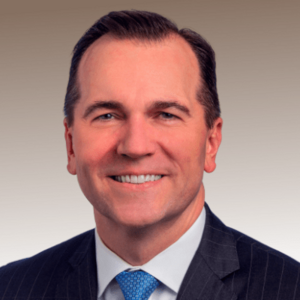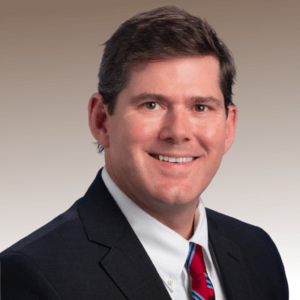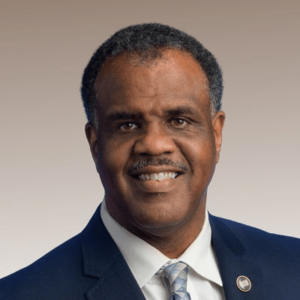Tennessee Democratic Party facts for kids
Quick facts for kids
Tennessee Democratic Party
|
|
|---|---|
 |
|
| Abbreviation | TNDP |
| Chairman | Rachel Campbell |
| Secretary | Ryan Scofield |
| Senate Minority Leader | Raumesh Akbari |
| House Minority Leader | Karen Camper |
| Founder | Andrew Jackson, John Overton, John H. Eaton, William B. Lewis, Andrew Jackson Donelson, and John Catron |
| Founded | 1826 |
| Headquarters | 4900 Centennial Blvd. Ste 300, Nashville, Tennessee |
| Student wing | Tennessee High School Democrats Tennessee College Democrats |
| Youth wing | Tennessee Young Democrats |
| Women's wing | Tennessee Federation of Democratic Women |
| Ideology | Modern liberalism |
| Political position | Center-left |
| National affiliation | Democratic Party |
| Colors | Blue |
| Seats in the U.S. Senate |
0 / 2
|
| Seats in the U.S. House |
1 / 9
|
| Seats in the State Senate |
6 / 33
|
| Seats in the State House |
24 / 99
|
| Election symbol | |
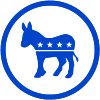 |
|
The Tennessee Democratic Party (TNDP) is the state branch of the national Democratic Party in Tennessee. It was started in 1826 as the Jacksonian Party. This party grew from the ideas of President Andrew Jackson in the 1820s.
After Jackson left office, the Democratic Party faced challenges in Tennessee. The Whig Party became very strong until it ended after the 1852 election. Before the Civil War, the Democratic Party became the main party in Tennessee. After the war, the Republican Party was in charge during Reconstruction. But once Reconstruction ended, the Democratic Party controlled Tennessee politics for a long time. This changed in 2011 when the Republican Party took strong control of the state government.
Contents
Early Days of Tennessee Politics
Before 1824, there weren't many political parties in Tennessee. Since Tennessee joined the United States in 1796, people mostly voted for the Democratic-Republican Party. In the 1824 election, Andrew Jackson, a famous military general and U.S. Senator from Tennessee, ran for president. He ran against John Quincy Adams, who was the Secretary of State.
Both Adams and Jackson were from the same party, but it had split into different groups. Jackson won the most votes from the public and the most electoral votes. However, he didn't have enough Electoral College votes to win right away. So, the election went to the House of Representatives. The House had to choose from the top three candidates: John Quincy Adams, Andrew Jackson, and Henry Clay from Kentucky. Clay was the Speaker of the House. He liked Adams' plans for improving the country, so he supported Adams. This helped Adams win the election. After Adams became president, he made Clay his Secretary of State. This made Jackson and his supporters very angry.
The Jacksonian Party and Beyond (1825-1860)
Between 1825 and 1826, Jackson's supporters prepared for him to run again in 1828. Even though Jackson didn't say it publicly, he was planning to win. His loyal advisors helped form the Jacksonian Party in 1826. This party, with help from New York politician Martin Van Buren, became the main political party in the United States from 1829 to 1839. In Tennessee, the party didn't have a formal structure at first, but it didn't matter as long as Jackson was president.
When Jackson left the White House, his Vice President, Martin Van Buren, was his chosen successor for the 1836 election. By then, the Whig Party was a strong opponent. Jackson's Democratic Party had trouble getting Van Buren elected, especially in Tennessee. Jackson campaigned hard for Van Buren. However, Tennessee Senator Hugh Lawson White won Tennessee's electoral votes instead of Van Buren. This started a trend where Tennessee voters chose Whig Party candidates in presidential elections from 1836 to 1852.
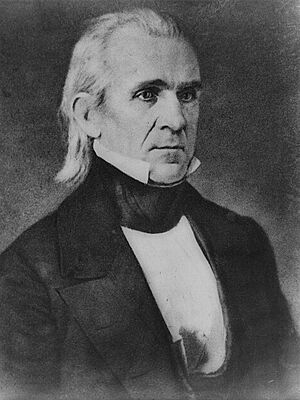
For other elections during this time, both Whigs and Democrats won offices. This continued until the Whig Party broke apart in 1854. In 1856, Tennessee voted for a Democrat for president for the first time since 1836. They voted for James Buchanan. By the 1860 election, the country was very divided over slavery. Tennessee narrowly voted for John Bell of the Constitutional Union Party. Most Tennesseans wanted to keep the country together. But by June 1861, Tennessee voted to leave the Union. It was the last Southern state to join the Confederacy.
After the Civil War to the New Deal Era
After the Civil War, Tennessee's political scene changed. Tennessee had been under military control since February 1862. This was when Union forces captured Nashville, the state capital. When civilian government returned, the Republican Party took control in March 1865. This was helped by a rule from Military Governor Andrew Johnson that stopped Confederate supporters from holding office. Republicans gained control of the General Assembly and the Governor's office. William G. Brownlow became the first Republican governor.
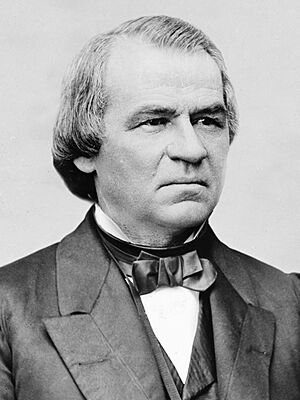
During the years Republicans controlled the General Assembly, they gave voting rights to newly freed slaves. They also took away voting rights from former Confederates. They passed a law allowing the governor to declare Martial Law to fight the Ku Klux Klan. However, by 1869, Republican power in state politics began to fade. Democrats in the state took control of the government. The Democratic Party then worked to undo the changes made by Governor Brownlow.
By the end of Reconstruction in 1877, Democrats were firmly in charge of Tennessee's government. But this came at a great cost to many African American voters in the state. From the end of the Civil War until the Civil Rights Movement of the 1950s and 1960s, African Americans mostly voted for Republicans. But when Southern Democrats regained control, they passed Jim Crow Laws. These laws made racist views part of the law. Because of these laws, African Americans faced extreme racial discrimination, lynchings, and segregation for many years.
Throughout the rest of the 1800s, Tennessee voters mostly elected Democrats to state and federal offices. Between 1869 and 1900, only two Republicans became Governor of Tennessee: Dewitt Clinton Senter and Alvin Hawkins. As the 19th century ended and the 20th century began, Tennessee voters still preferred the Democratic Party. However, the new century would test this loyalty.
Around 1900, the Temperance movement, which wanted to ban alcohol, gained strength in Tennessee. By 1908, those who supported prohibition had a strong ally in newspaper publisher Edward Carmack. Carmack challenged Democratic Governor Malcom Patterson, who was against Prohibition. The election was very close. Patterson narrowly won. After the election, Carmack was shot and killed in Nashville. Governor Patterson later pardoned the man who shot Carmack. Because of this, Republicans won the Governor's office in 1911 when Ben Hooper was elected.

By the 1920s, the Democratic Party's control in Tennessee began to weaken. Republican Warren G. Harding became the first Republican presidential candidate to win Tennessee since Ulysses S. Grant in 1868. In the late 1920s and early 1930s, important Tennessee Democrats gained national attention. Jo Byrns from Robertson County became Speaker of the House during President Franklin Roosevelt's time. Cordell Hull from Pickett County became Secretary of State and helped create the United Nations.
From the New Deal to Today
The Democratic Party was still the main party in Tennessee during the New Deal era. This period saw the rise of powerful political leaders in Memphis and Nashville. In Memphis, E.H. Crump gained power. He used his influence to get people he approved of elected. He had a lot of power until the mid-1940s, and his influence ended in the 1950s.
In the 1950s, Tennessee voters started to move away from the Democratic Party. This happened as the Civil Rights Movement grew stronger. Since 1952, Tennessee has voted for a Democratic president only four times: in 1964, 1976, 1992, and 1996. Starting in the late 1960s, Republicans began to take away the Democratic Party's control. This began in 1967 when Howard Baker was elected to the U.S. Senate. Then Bill Brock was elected to the U.S. Senate, and Winfield Dunn became governor in 1971.
Democratic control continued to weaken throughout the rest of the 20th century. Republicans gained more support from conservative voters in the state. By 2000, Tennessee was in the spotlight for the election between Vice President Al Gore of Carthage, Tennessee and George W. Bush of Texas. Gore campaigned hard in Tennessee, but George W. Bush won the state's electoral votes.
After 2000, the Democratic Party's power kept slipping. The last time a Democrat won a statewide election was in 2006, when Governor Phil Bredesen won re-election. After 2011, the Democratic Party was completely out of power for the first time since Reconstruction. Since then, the party is seen as less important in Tennessee politics, as Republicans have strong control over the state government.

On April 6, 2023, three Democrats, Rep. Justin Jones, Rep. Gloria Johnson, and Rep. Justin J. Pearson, faced being removed from the Tennessee House of Representatives. This was because they protested for gun violence prevention and stood in the middle of the House floor. Speaker Cameron Sexton compared their protest to the attack on the U.S. Capitol on January 6, 2021. Republicans voted to remove both Justin Jones and Justin J. Pearson from the House. However, they voted not to remove Rep. Gloria Johnson. Later, Jones and Pearson were both sent back to the House by their local governments and voters.
After President Joe Biden decided not to run for re-election, Tennessee's group of delegates to the 2024 Democratic National Convention was the first state to support Vice President Kamala Harris for her 2024 presidential campaign.
Democratic Officials in Tennessee
Members of Congress
Currently, Tennessee's group of U.S. Representatives includes only one Democrat out of nine seats. Before the 2022 elections, the Republican majority redrew Nashville into three Congressional Districts. This was done to make sure Republicans had a very strong majority in Tennessee's Congressional delegation. The last time Democrats had more seats in Tennessee's Congressional Delegation was in 2010. Back then, Tennessee Democrats held 5 out of the state's 9 House seats.
| District | Member | Photo |
|---|---|---|
| 9th Congressional District | Steve Cohen |
Statewide Offices
Currently, no Democrat holds a statewide elected office in Tennessee. The last time a Democrat was elected statewide was when former Governor Phil Bredesen won re-election in 2006.
State Legislative Leaders
Since 2011, Tennessee Democrats have been a small minority in both the Tennessee House of Representatives and Tennessee Senate. Right now, Tennessee Democrats hold 24 seats in the Tennessee State House and 6 seats in the Tennessee State Senate.
| Position | State House District | Member | Photo |
|---|---|---|---|
| Minority Leader | District 87 | Karen Camper | |
| Caucus Chairman | District 55 | John Ray Clemmons | |
| Assistant Minority Leader | District 58 | Harold Love Jr. | |
| Caucus Vice Chairman | District 56 | Bob Freeman | |
| Minority Floor Leader | District 91 | Torrey Harris | |
| Assistant Floor Leader | District 60 | Shaundelle Brooks | |
| Minority Whip | District 15 | Sam McKenzie | |
| Caucus Secretary | District 28 | Yusuf Hakeem | |
| Caucus Treasurer | District 67 | Ronnie Glynn | |
| Minority Leader Pro Tempore | District 88 | Larry J. Miller |
| Position | State Senate District | Member | Photo |
|---|---|---|---|
| Minority Leader | District 29 | Raumesh Akbari | |
| Caucus Chairman | District 33 | London Lamar |
Mayors
Here are some cities and counties in Tennessee with Democratic mayors:
- Nashville-Davidson County: Freddie O'Connell
- Memphis: Paul Young
- Shelby County: Lee Harris
- Knoxville: Indya Kincannon
- Clarksville: Joe Pitts
Party Leadership
The Tennessee Democratic Party is led by a Chair, Vice Chair, Secretary, and Treasurer. These leaders are chosen by the State Executive Committee. This committee has one man and one woman from each of Tennessee's 33 State Senate Districts. On January 25, 2024, Rachel Campbell was elected Chair of the Tennessee Democratic Party. Dr. J. Nathan Higdon became Vice Chair, Ryan Scofield became Secretary, and Carol V. Abney became Treasurer.
- Chairman – Rachel Campbell
- Vice Chairwoman – Dr. J. Nathan Higdon
- Treasurer – Carol V. Abney
- Secretary – Ryan Scofield
- Tennessee Senate Caucus Leader – Sen. London Lamar
- Tennessee House Caucus Leader – Rep. John Ray Clemmons
- East Tennessee Regional Vice Chairs
- Terry Marek (Sullivan County)
- Debbie Harley-McClaskey (Washington County)
- Middle Tennessee Regional Vice Chairs
- Lee Jones (Davidson County)
- Bobby Bush (Coffee County)
- West Tennessee Regional Vice Chairs
- Tammy Floyd Wade (Gibson County)
- Dave Cambron (Shelby County)
State Executive Committee
The Tennessee Democratic Party's Executive Committee has 66 elected members. They come from each of Tennessee's 33 Senatorial Districts. The committee also has seven special members who represent groups that help Democrats in Tennessee.
| State Senate District | Male Committee Member | Term | Female Committee Member | Term |
|---|---|---|---|---|
| District 1 | Jack Waggett | Ending August 2026 | Dr. Patricia Waters | Ending August 2026 |
| District 2 | J. Nathan Higdon, PhD | Ending August 2026 | Sue Dubois | Ending August 2026 |
| District 3 | vacant | Debbie Harley-McClaskey | Ending August 2026 | |
| District 4 | Terry Marek | Ending August 2026 | Lori Love | Ending August 2026 |
| District 5 | Jack Vaughan | Ending August 2026 | Anne Backus | Ending August 2026 |
| District 6 | Mark Siegel | Ending August 2026 | Sylvia Woods | Ending August 2026 |
| District 7 | Zach Fetzer | Ending August 2026 | Dana Moran | Ending August 2026 |
| District 8 | Rodney Fugate | Ending August 2026 | Barbara Wagner | Ending August 2026 |
| District 9 | Noah Adkins | Ending August 2026 | Majorie Ramsey | Ending August 2026 |
| District 10 | Chris Anderson | Ending August 2026 | vacant | |
| District 11 | Ryan Scofield | Ending August 2026 | Lisa Crowder | Ending August 2026 |
| District 12 | Robert Young | Ending August 2026 | Carol V. Abney | Ending August 2026 |
| District 13 | Matthew Burke | Ending August 2026 | Kimberli Rose Jensen | Ending August 2026 |
| District 14 | Matt Ferry | Ending August 2026 | Jane Tucker | Ending August 2026 |
| District 15 | Troy Smith | Ending August 2026 | Anne Ferrell Quillen | Ending August 2026 |
| District 16 | Bobby Bush | Ending August 2026 | Victoria Broderick | Ending August 2026 |
| District 17 | Aubrey Givens | Ending August 2026 | Sherry Jones | Ending August 2026 |
| District 18 | Tyler Templeton | Ending August 2026 | Megan Lange | Ending August 2026 |
| District 19 | Jonathan Saad | Ending August 2026 | Dr. Michelle V. Brown | Ending August 2026 |
| District 20 | Matt Anderson | Ending August 2026 | Lee Jones | Ending August 2026 |
| District 21 | John Summers | Ending August 2026 | Jennifer Watson | Ending August 2026 |
| District 22 | Rod Mills | Ending August 2026 | Karen Sorenson | Ending August 2026 |
| District 23 | Zach Kinslow | Ending August 2026 | Emily McCartney | Ending August 2026 |
| District 24 | Mark Flake | Ending August 2026 | Tammy Floyd-Wade | Ending August 2026 |
| District 25 | Byron Elam | Ending August 2026 | Patsy Johnson | Ending August 2026 |
| District 26 | Randall Rice | Ending August 2026 | Meryl Rice | Ending August 2026 |
| District 27 | Joshua Patrick | Ending August 2026 | Jody Barnwell Smith | Ending August 2026 |
| District 28 | Seth Campbell | Ending August 2026 | Vicki Hale | Ending August 2026 |
| District 29 | Darrick Harris | Ending August 2026 | Allison Brownlee | Ending August 2026 |
| District 30 | Allan Creasy | Ending August 2026 | Jasmine Boyd-Wilson | Ending August 2026 |
| District 31 | Dave Cambron | Ending August 2026 | Sarah Freeman | Ending August 2026 |
| District 32 | Gregory Patrick | Ending August 2026 | Deborah Reed | Ending August 2026 |
| District 33 | Jon Carroll | Ending August 2026 | Rosemary Winters | Ending August 2026 |
| Representative | Organization |
|---|---|
| Sen. London Lamar | Tennessee Senate Democratic Caucus |
| Rep. John Ray Clemmons | Tennessee House Democratic Caucus |
| Jordan Wilkins | Tennessee Democratic County Chairs Association (TDCCA) |
| Edee Webb | Tennessee Federation of Democratic Women (TFDW) |
| Will Bowen | Tennessee Young Democrats (TNYD) |
| Farrah Renfroe | Tennessee College Democrats (TNCD) |
| Jacob Francy | Tennessee High School Democrats (TNHSD) |
Tennessee's Democratic National Committee Members
These are the members from Tennessee on the Democratic National Committee:
- Rachel Campbell– Chair
- Dr. J. Nathan Higdon – Vice Chair
- Bill Owen – East Tennessee
- Carol V. Abney – Middle Tennessee
- Deborah Reed – West Tennessee
- Ray Curry
- David Wilhelm
See also
- Tennessee Republican Party
- Political party strength in Tennessee





